Health and Safety and Risk Management Assessment Report Overview
VerifiedAdded on 2022/08/14
|14
|3263
|21
Report
AI Summary
This health and safety assessment report focuses on risk management within the workplace, emphasizing the responsibilities of both employers and employees in minimizing hazards. It delves into key legislation like the Health and Safety at Work Act 1974 (HASAWA) and Approved Code of Practices (ACOPS), highlighting the importance of safety policies, safe systems of work, and regular safety audits. The report outlines the five steps of risk assessment, the duties of employers, and the rights of employees, supported by examples from a paint manufacturing company. It includes a safety audit checklist for a specific IT solutions company in Melbourne, covering various aspects of workplace safety. The report also examines relevant health and safety legislation, such as the Management of Health and Safety at Work Regulations 1999 and the Personal Protective Equipment at Work Regulations 1992, concluding with an emphasis on the importance of a safe and healthy work environment to boost productivity.
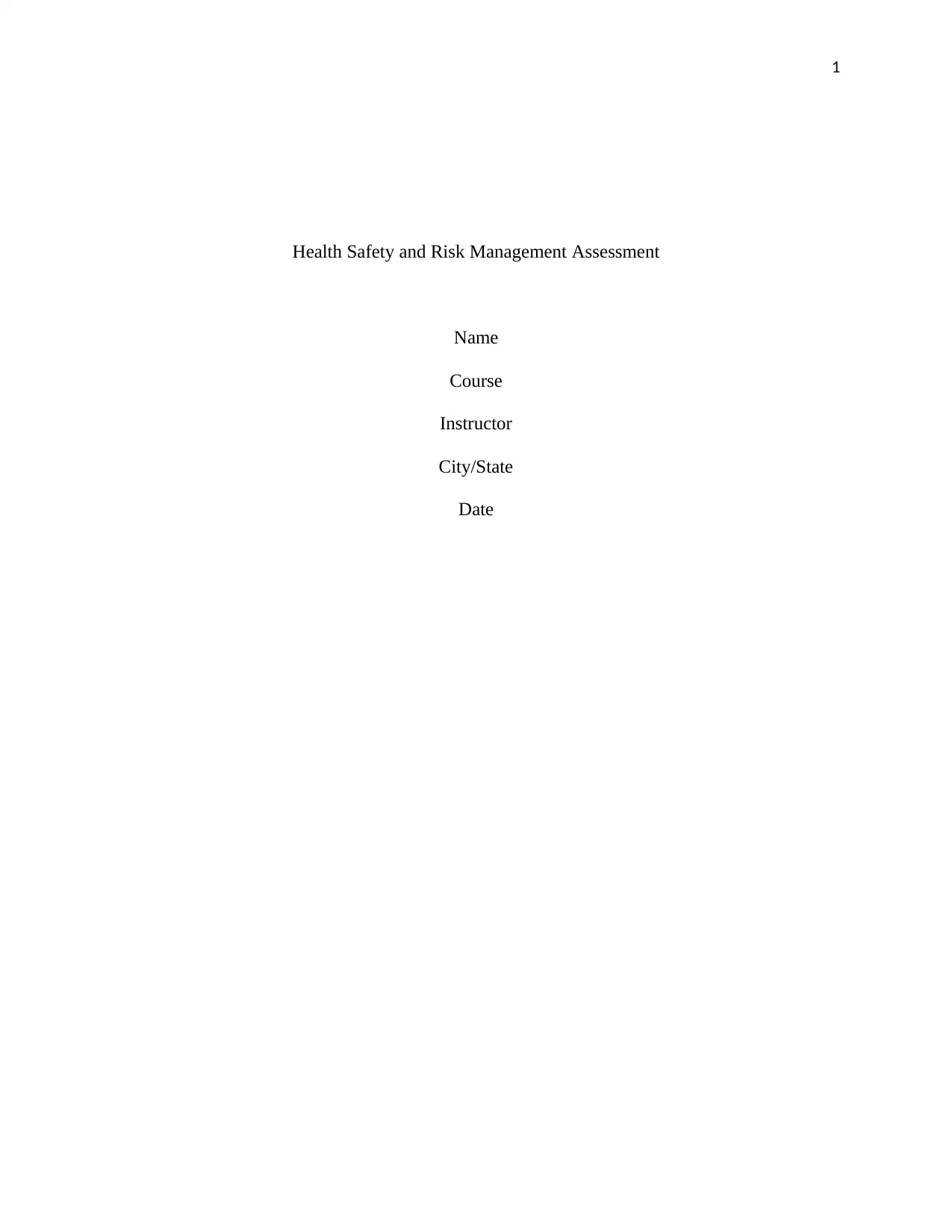
1
Health Safety and Risk Management Assessment
Name
Course
Instructor
City/State
Date
Health Safety and Risk Management Assessment
Name
Course
Instructor
City/State
Date
Paraphrase This Document
Need a fresh take? Get an instant paraphrase of this document with our AI Paraphraser
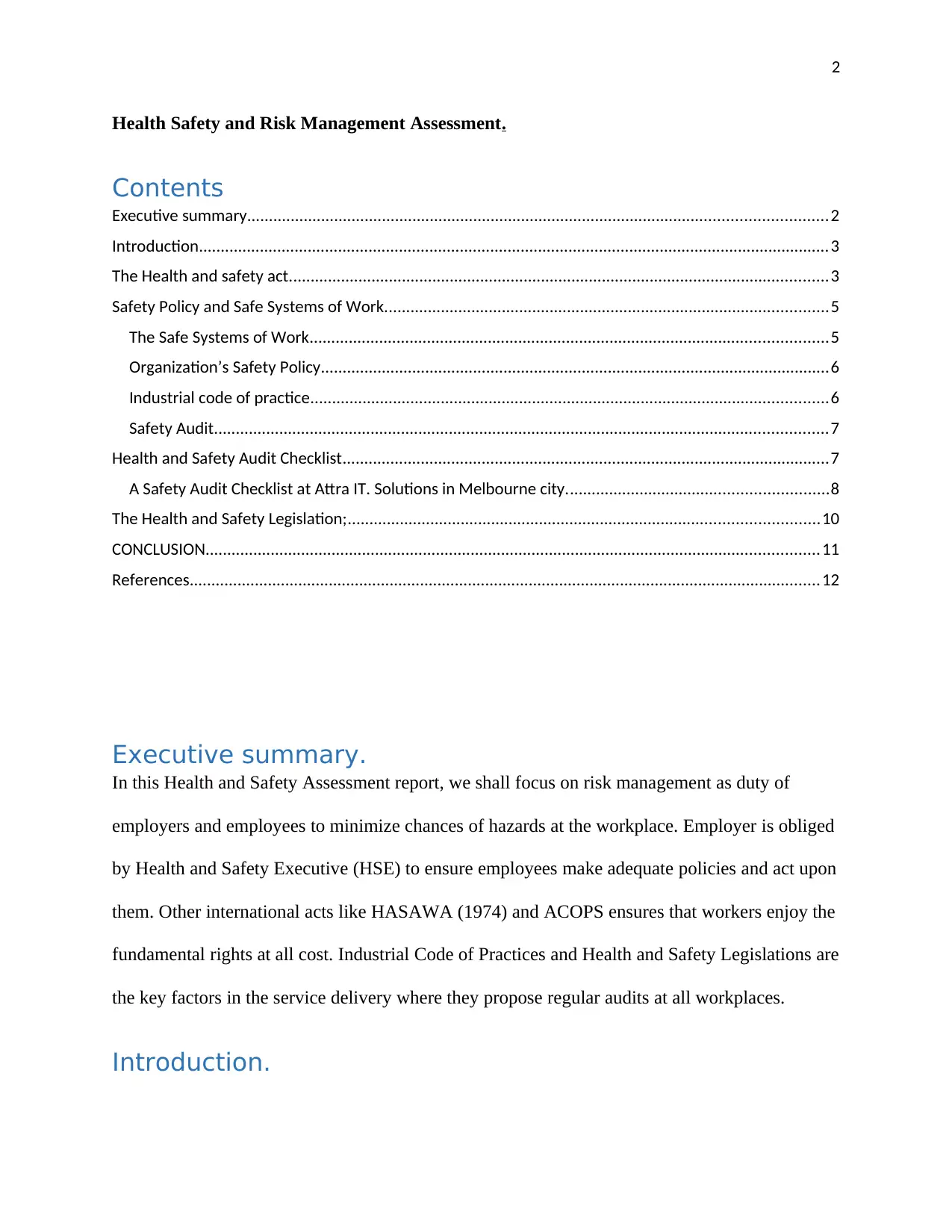
2
Health Safety and Risk Management Assessment.
Contents
Executive summary.....................................................................................................................................2
Introduction.................................................................................................................................................3
The Health and safety act............................................................................................................................3
Safety Policy and Safe Systems of Work......................................................................................................5
The Safe Systems of Work.......................................................................................................................5
Organization’s Safety Policy.....................................................................................................................6
Industrial code of practice.......................................................................................................................6
Safety Audit.............................................................................................................................................7
Health and Safety Audit Checklist................................................................................................................7
A Safety Audit Checklist at Attra IT. Solutions in Melbourne city............................................................8
The Health and Safety Legislation;............................................................................................................10
CONCLUSION.............................................................................................................................................11
References.................................................................................................................................................12
Executive summary.
In this Health and Safety Assessment report, we shall focus on risk management as duty of
employers and employees to minimize chances of hazards at the workplace. Employer is obliged
by Health and Safety Executive (HSE) to ensure employees make adequate policies and act upon
them. Other international acts like HASAWA (1974) and ACOPS ensures that workers enjoy the
fundamental rights at all cost. Industrial Code of Practices and Health and Safety Legislations are
the key factors in the service delivery where they propose regular audits at all workplaces.
Introduction.
Health Safety and Risk Management Assessment.
Contents
Executive summary.....................................................................................................................................2
Introduction.................................................................................................................................................3
The Health and safety act............................................................................................................................3
Safety Policy and Safe Systems of Work......................................................................................................5
The Safe Systems of Work.......................................................................................................................5
Organization’s Safety Policy.....................................................................................................................6
Industrial code of practice.......................................................................................................................6
Safety Audit.............................................................................................................................................7
Health and Safety Audit Checklist................................................................................................................7
A Safety Audit Checklist at Attra IT. Solutions in Melbourne city............................................................8
The Health and Safety Legislation;............................................................................................................10
CONCLUSION.............................................................................................................................................11
References.................................................................................................................................................12
Executive summary.
In this Health and Safety Assessment report, we shall focus on risk management as duty of
employers and employees to minimize chances of hazards at the workplace. Employer is obliged
by Health and Safety Executive (HSE) to ensure employees make adequate policies and act upon
them. Other international acts like HASAWA (1974) and ACOPS ensures that workers enjoy the
fundamental rights at all cost. Industrial Code of Practices and Health and Safety Legislations are
the key factors in the service delivery where they propose regular audits at all workplaces.
Introduction.
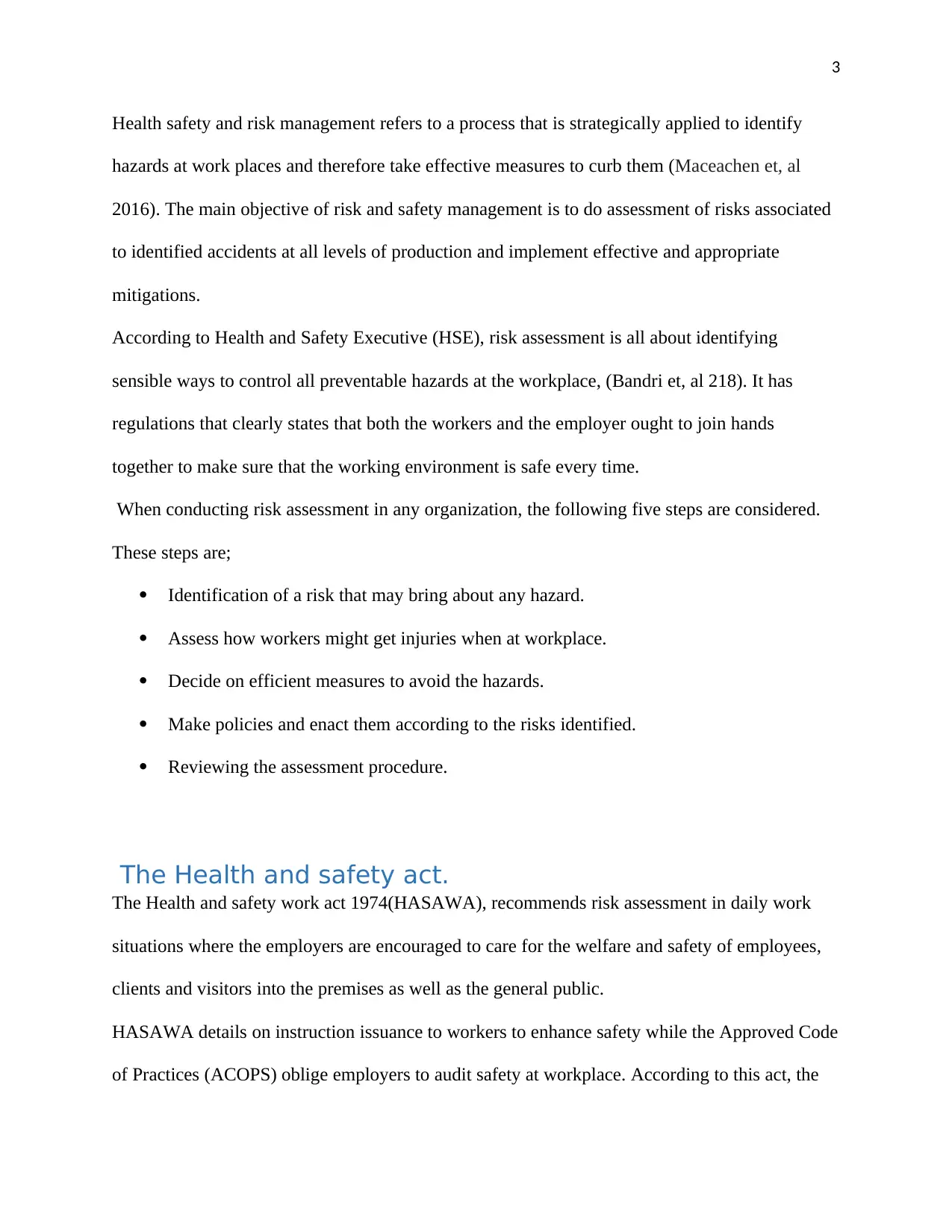
3
Health safety and risk management refers to a process that is strategically applied to identify
hazards at work places and therefore take effective measures to curb them (Maceachen et, al
2016). The main objective of risk and safety management is to do assessment of risks associated
to identified accidents at all levels of production and implement effective and appropriate
mitigations.
According to Health and Safety Executive (HSE), risk assessment is all about identifying
sensible ways to control all preventable hazards at the workplace, (Bandri et, al 218). It has
regulations that clearly states that both the workers and the employer ought to join hands
together to make sure that the working environment is safe every time.
When conducting risk assessment in any organization, the following five steps are considered.
These steps are;
Identification of a risk that may bring about any hazard.
Assess how workers might get injuries when at workplace.
Decide on efficient measures to avoid the hazards.
Make policies and enact them according to the risks identified.
Reviewing the assessment procedure.
The Health and safety act.
The Health and safety work act 1974(HASAWA), recommends risk assessment in daily work
situations where the employers are encouraged to care for the welfare and safety of employees,
clients and visitors into the premises as well as the general public.
HASAWA details on instruction issuance to workers to enhance safety while the Approved Code
of Practices (ACOPS) oblige employers to audit safety at workplace. According to this act, the
Health safety and risk management refers to a process that is strategically applied to identify
hazards at work places and therefore take effective measures to curb them (Maceachen et, al
2016). The main objective of risk and safety management is to do assessment of risks associated
to identified accidents at all levels of production and implement effective and appropriate
mitigations.
According to Health and Safety Executive (HSE), risk assessment is all about identifying
sensible ways to control all preventable hazards at the workplace, (Bandri et, al 218). It has
regulations that clearly states that both the workers and the employer ought to join hands
together to make sure that the working environment is safe every time.
When conducting risk assessment in any organization, the following five steps are considered.
These steps are;
Identification of a risk that may bring about any hazard.
Assess how workers might get injuries when at workplace.
Decide on efficient measures to avoid the hazards.
Make policies and enact them according to the risks identified.
Reviewing the assessment procedure.
The Health and safety act.
The Health and safety work act 1974(HASAWA), recommends risk assessment in daily work
situations where the employers are encouraged to care for the welfare and safety of employees,
clients and visitors into the premises as well as the general public.
HASAWA details on instruction issuance to workers to enhance safety while the Approved Code
of Practices (ACOPS) oblige employers to audit safety at workplace. According to this act, the
⊘ This is a preview!⊘
Do you want full access?
Subscribe today to unlock all pages.

Trusted by 1+ million students worldwide
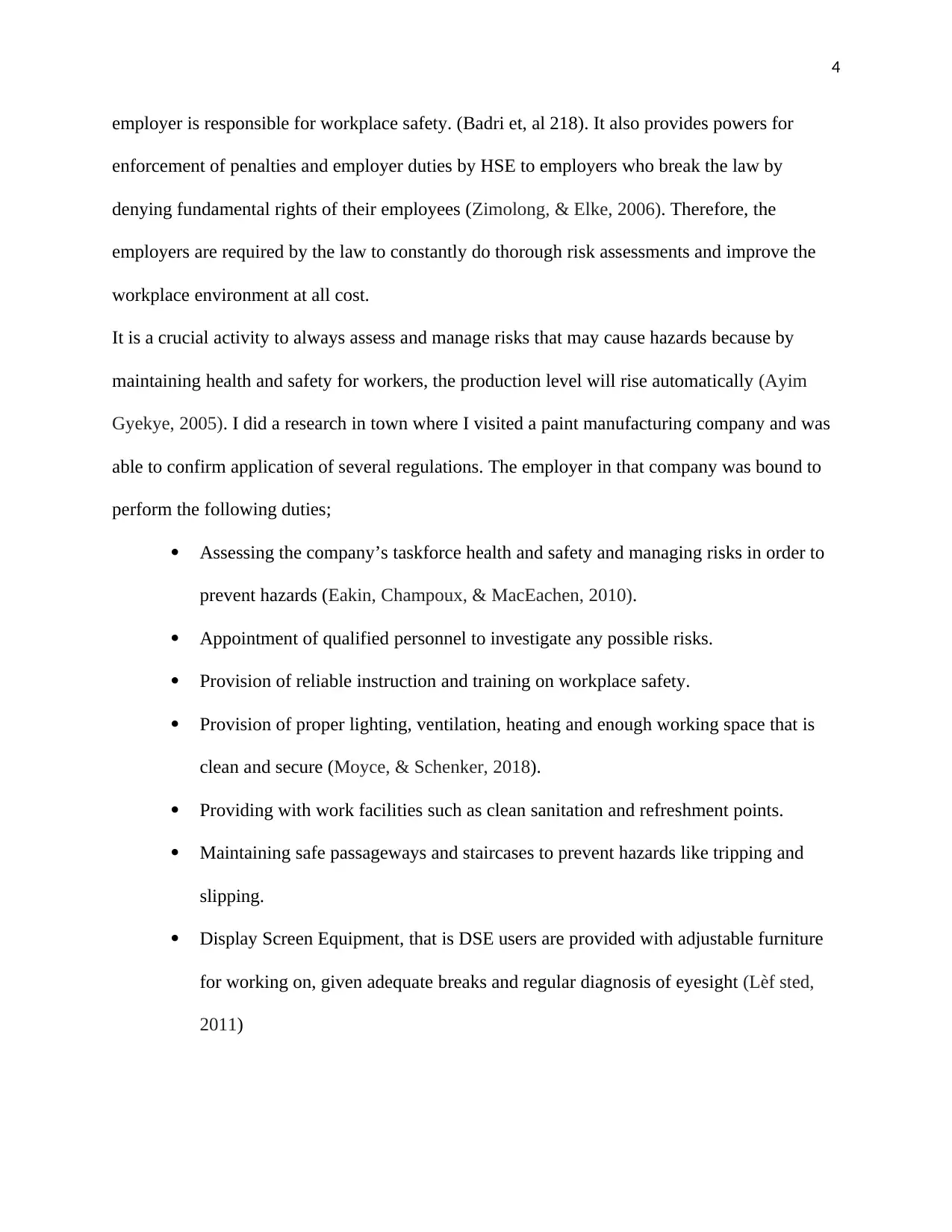
4
employer is responsible for workplace safety. (Badri et, al 218). It also provides powers for
enforcement of penalties and employer duties by HSE to employers who break the law by
denying fundamental rights of their employees (Zimolong, & Elke, 2006). Therefore, the
employers are required by the law to constantly do thorough risk assessments and improve the
workplace environment at all cost.
It is a crucial activity to always assess and manage risks that may cause hazards because by
maintaining health and safety for workers, the production level will rise automatically (Ayim
Gyekye, 2005). I did a research in town where I visited a paint manufacturing company and was
able to confirm application of several regulations. The employer in that company was bound to
perform the following duties;
Assessing the company’s taskforce health and safety and managing risks in order to
prevent hazards (Eakin, Champoux, & MacEachen, 2010).
Appointment of qualified personnel to investigate any possible risks.
Provision of reliable instruction and training on workplace safety.
Provision of proper lighting, ventilation, heating and enough working space that is
clean and secure (Moyce, & Schenker, 2018).
Providing with work facilities such as clean sanitation and refreshment points.
Maintaining safe passageways and staircases to prevent hazards like tripping and
slipping.
Display Screen Equipment, that is DSE users are provided with adjustable furniture
for working on, given adequate breaks and regular diagnosis of eyesight (Lèf sted,
2011)
employer is responsible for workplace safety. (Badri et, al 218). It also provides powers for
enforcement of penalties and employer duties by HSE to employers who break the law by
denying fundamental rights of their employees (Zimolong, & Elke, 2006). Therefore, the
employers are required by the law to constantly do thorough risk assessments and improve the
workplace environment at all cost.
It is a crucial activity to always assess and manage risks that may cause hazards because by
maintaining health and safety for workers, the production level will rise automatically (Ayim
Gyekye, 2005). I did a research in town where I visited a paint manufacturing company and was
able to confirm application of several regulations. The employer in that company was bound to
perform the following duties;
Assessing the company’s taskforce health and safety and managing risks in order to
prevent hazards (Eakin, Champoux, & MacEachen, 2010).
Appointment of qualified personnel to investigate any possible risks.
Provision of reliable instruction and training on workplace safety.
Provision of proper lighting, ventilation, heating and enough working space that is
clean and secure (Moyce, & Schenker, 2018).
Providing with work facilities such as clean sanitation and refreshment points.
Maintaining safe passageways and staircases to prevent hazards like tripping and
slipping.
Display Screen Equipment, that is DSE users are provided with adjustable furniture
for working on, given adequate breaks and regular diagnosis of eyesight (Lèf sted,
2011)
Paraphrase This Document
Need a fresh take? Get an instant paraphrase of this document with our AI Paraphraser
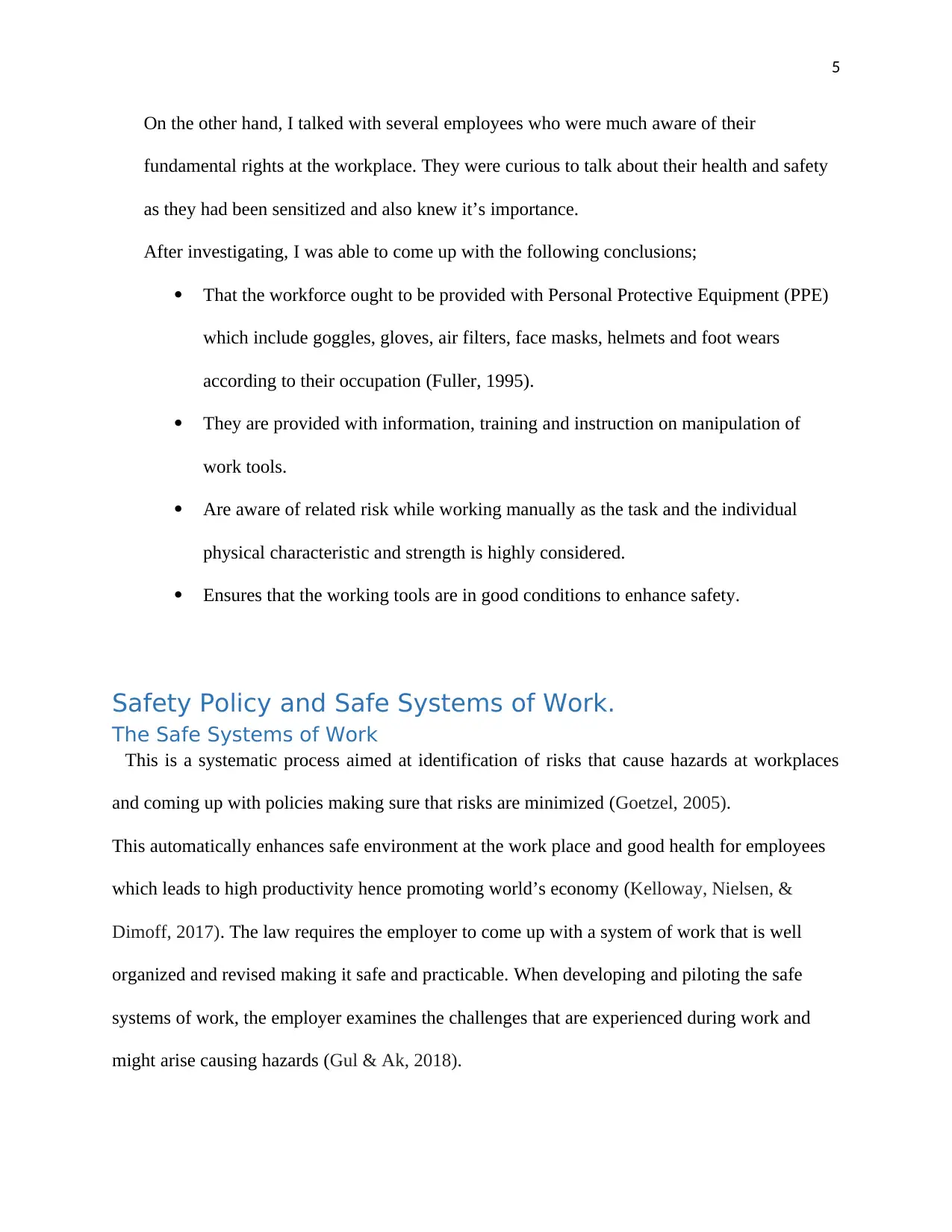
5
On the other hand, I talked with several employees who were much aware of their
fundamental rights at the workplace. They were curious to talk about their health and safety
as they had been sensitized and also knew it’s importance.
After investigating, I was able to come up with the following conclusions;
That the workforce ought to be provided with Personal Protective Equipment (PPE)
which include goggles, gloves, air filters, face masks, helmets and foot wears
according to their occupation (Fuller, 1995).
They are provided with information, training and instruction on manipulation of
work tools.
Are aware of related risk while working manually as the task and the individual
physical characteristic and strength is highly considered.
Ensures that the working tools are in good conditions to enhance safety.
Safety Policy and Safe Systems of Work.
The Safe Systems of Work
This is a systematic process aimed at identification of risks that cause hazards at workplaces
and coming up with policies making sure that risks are minimized (Goetzel, 2005).
This automatically enhances safe environment at the work place and good health for employees
which leads to high productivity hence promoting world’s economy (Kelloway, Nielsen, &
Dimoff, 2017). The law requires the employer to come up with a system of work that is well
organized and revised making it safe and practicable. When developing and piloting the safe
systems of work, the employer examines the challenges that are experienced during work and
might arise causing hazards (Gul & Ak, 2018).
On the other hand, I talked with several employees who were much aware of their
fundamental rights at the workplace. They were curious to talk about their health and safety
as they had been sensitized and also knew it’s importance.
After investigating, I was able to come up with the following conclusions;
That the workforce ought to be provided with Personal Protective Equipment (PPE)
which include goggles, gloves, air filters, face masks, helmets and foot wears
according to their occupation (Fuller, 1995).
They are provided with information, training and instruction on manipulation of
work tools.
Are aware of related risk while working manually as the task and the individual
physical characteristic and strength is highly considered.
Ensures that the working tools are in good conditions to enhance safety.
Safety Policy and Safe Systems of Work.
The Safe Systems of Work
This is a systematic process aimed at identification of risks that cause hazards at workplaces
and coming up with policies making sure that risks are minimized (Goetzel, 2005).
This automatically enhances safe environment at the work place and good health for employees
which leads to high productivity hence promoting world’s economy (Kelloway, Nielsen, &
Dimoff, 2017). The law requires the employer to come up with a system of work that is well
organized and revised making it safe and practicable. When developing and piloting the safe
systems of work, the employer examines the challenges that are experienced during work and
might arise causing hazards (Gul & Ak, 2018).
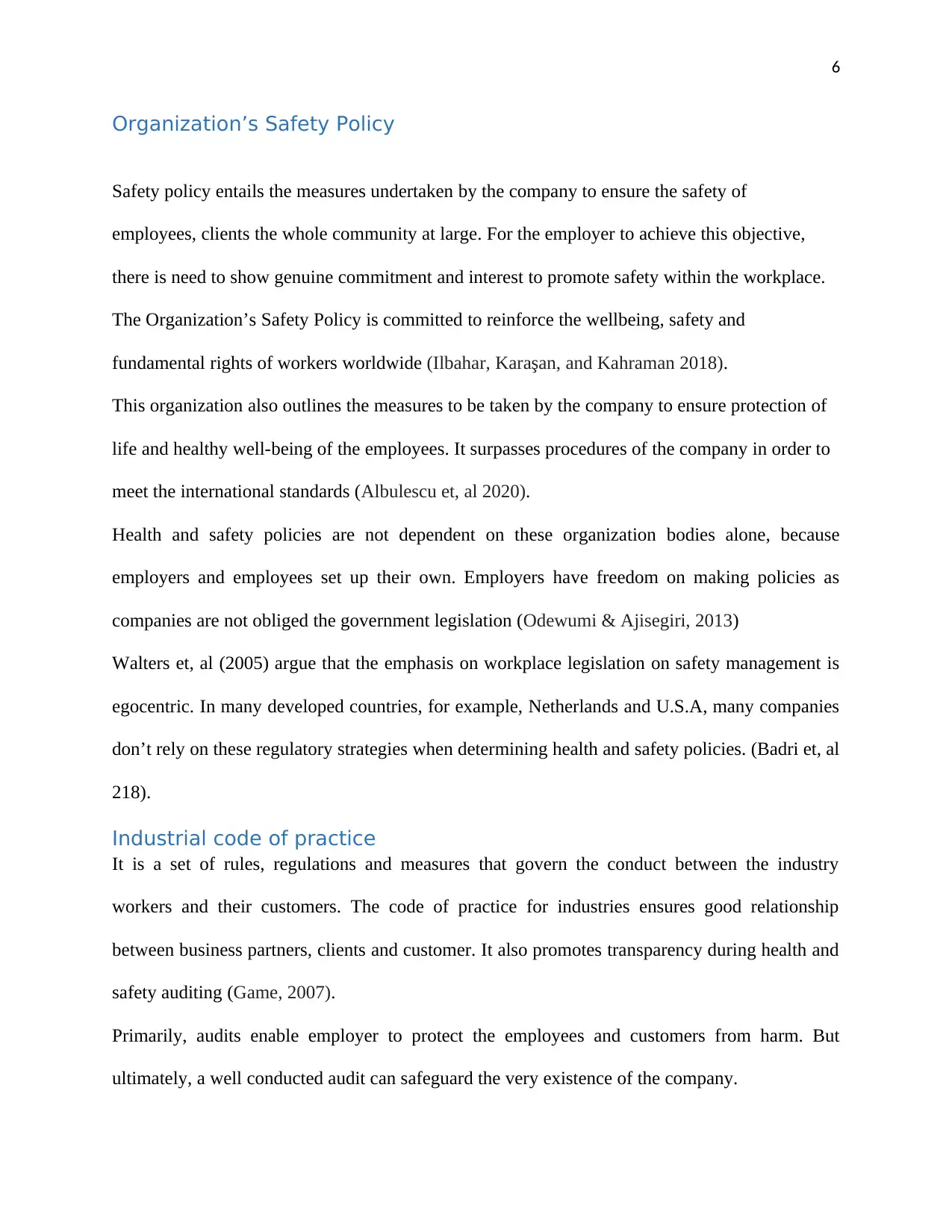
6
Organization’s Safety Policy
Safety policy entails the measures undertaken by the company to ensure the safety of
employees, clients the whole community at large. For the employer to achieve this objective,
there is need to show genuine commitment and interest to promote safety within the workplace.
The Organization’s Safety Policy is committed to reinforce the wellbeing, safety and
fundamental rights of workers worldwide (Ilbahar, Karaşan, and Kahraman 2018).
This organization also outlines the measures to be taken by the company to ensure protection of
life and healthy well-being of the employees. It surpasses procedures of the company in order to
meet the international standards (Albulescu et, al 2020).
Health and safety policies are not dependent on these organization bodies alone, because
employers and employees set up their own. Employers have freedom on making policies as
companies are not obliged the government legislation (Odewumi & Ajisegiri, 2013)
Walters et, al (2005) argue that the emphasis on workplace legislation on safety management is
egocentric. In many developed countries, for example, Netherlands and U.S.A, many companies
don’t rely on these regulatory strategies when determining health and safety policies. (Badri et, al
218).
Industrial code of practice
It is a set of rules, regulations and measures that govern the conduct between the industry
workers and their customers. The code of practice for industries ensures good relationship
between business partners, clients and customer. It also promotes transparency during health and
safety auditing (Game, 2007).
Primarily, audits enable employer to protect the employees and customers from harm. But
ultimately, a well conducted audit can safeguard the very existence of the company.
Organization’s Safety Policy
Safety policy entails the measures undertaken by the company to ensure the safety of
employees, clients the whole community at large. For the employer to achieve this objective,
there is need to show genuine commitment and interest to promote safety within the workplace.
The Organization’s Safety Policy is committed to reinforce the wellbeing, safety and
fundamental rights of workers worldwide (Ilbahar, Karaşan, and Kahraman 2018).
This organization also outlines the measures to be taken by the company to ensure protection of
life and healthy well-being of the employees. It surpasses procedures of the company in order to
meet the international standards (Albulescu et, al 2020).
Health and safety policies are not dependent on these organization bodies alone, because
employers and employees set up their own. Employers have freedom on making policies as
companies are not obliged the government legislation (Odewumi & Ajisegiri, 2013)
Walters et, al (2005) argue that the emphasis on workplace legislation on safety management is
egocentric. In many developed countries, for example, Netherlands and U.S.A, many companies
don’t rely on these regulatory strategies when determining health and safety policies. (Badri et, al
218).
Industrial code of practice
It is a set of rules, regulations and measures that govern the conduct between the industry
workers and their customers. The code of practice for industries ensures good relationship
between business partners, clients and customer. It also promotes transparency during health and
safety auditing (Game, 2007).
Primarily, audits enable employer to protect the employees and customers from harm. But
ultimately, a well conducted audit can safeguard the very existence of the company.
⊘ This is a preview!⊘
Do you want full access?
Subscribe today to unlock all pages.

Trusted by 1+ million students worldwide
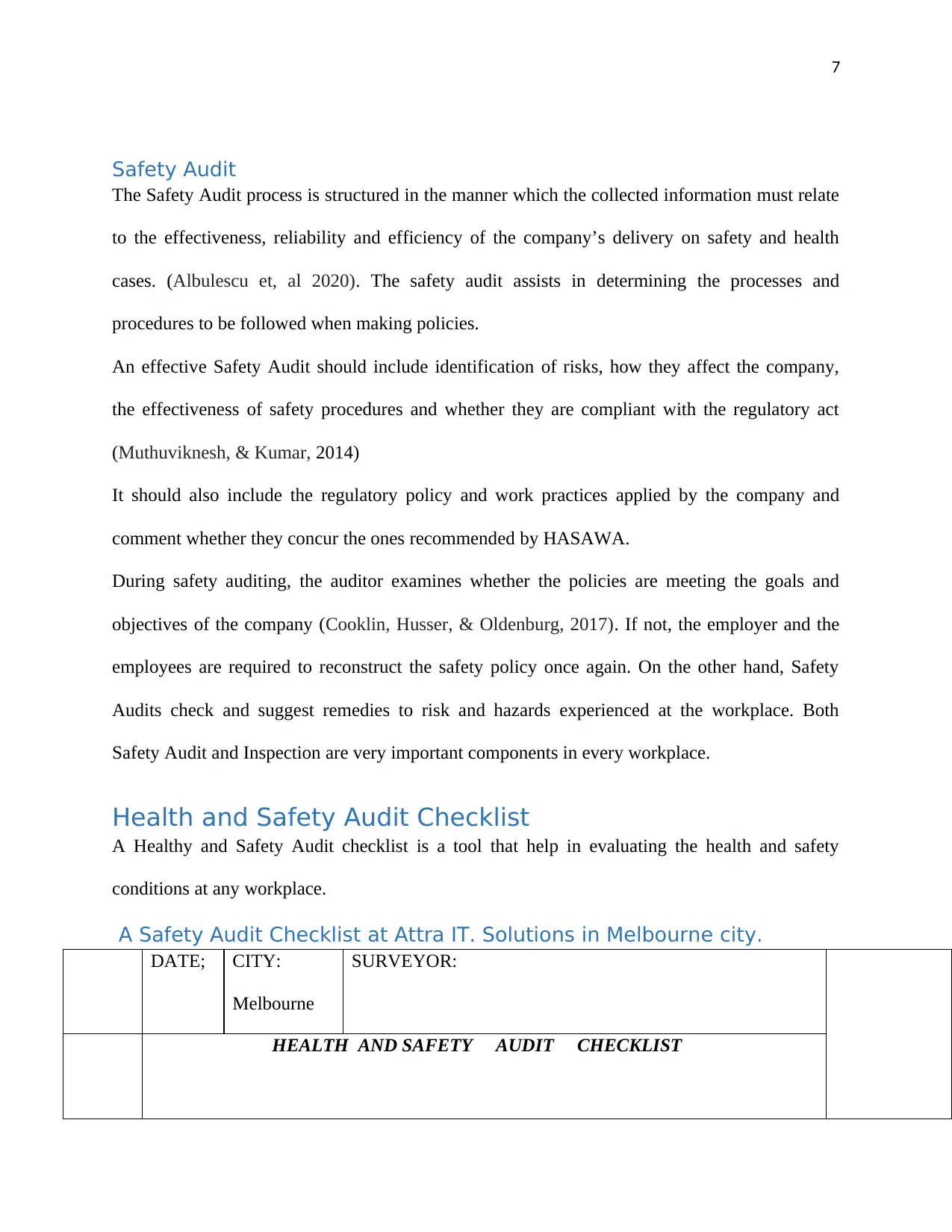
7
Safety Audit
The Safety Audit process is structured in the manner which the collected information must relate
to the effectiveness, reliability and efficiency of the company’s delivery on safety and health
cases. (Albulescu et, al 2020). The safety audit assists in determining the processes and
procedures to be followed when making policies.
An effective Safety Audit should include identification of risks, how they affect the company,
the effectiveness of safety procedures and whether they are compliant with the regulatory act
(Muthuviknesh, & Kumar, 2014)
It should also include the regulatory policy and work practices applied by the company and
comment whether they concur the ones recommended by HASAWA.
During safety auditing, the auditor examines whether the policies are meeting the goals and
objectives of the company (Cooklin, Husser, & Oldenburg, 2017). If not, the employer and the
employees are required to reconstruct the safety policy once again. On the other hand, Safety
Audits check and suggest remedies to risk and hazards experienced at the workplace. Both
Safety Audit and Inspection are very important components in every workplace.
Health and Safety Audit Checklist
A Healthy and Safety Audit checklist is a tool that help in evaluating the health and safety
conditions at any workplace.
A Safety Audit Checklist at Attra IT. Solutions in Melbourne city.
DATE; CITY:
Melbourne
SURVEYOR:
HEALTH AND SAFETY AUDIT CHECKLIST
Safety Audit
The Safety Audit process is structured in the manner which the collected information must relate
to the effectiveness, reliability and efficiency of the company’s delivery on safety and health
cases. (Albulescu et, al 2020). The safety audit assists in determining the processes and
procedures to be followed when making policies.
An effective Safety Audit should include identification of risks, how they affect the company,
the effectiveness of safety procedures and whether they are compliant with the regulatory act
(Muthuviknesh, & Kumar, 2014)
It should also include the regulatory policy and work practices applied by the company and
comment whether they concur the ones recommended by HASAWA.
During safety auditing, the auditor examines whether the policies are meeting the goals and
objectives of the company (Cooklin, Husser, & Oldenburg, 2017). If not, the employer and the
employees are required to reconstruct the safety policy once again. On the other hand, Safety
Audits check and suggest remedies to risk and hazards experienced at the workplace. Both
Safety Audit and Inspection are very important components in every workplace.
Health and Safety Audit Checklist
A Healthy and Safety Audit checklist is a tool that help in evaluating the health and safety
conditions at any workplace.
A Safety Audit Checklist at Attra IT. Solutions in Melbourne city.
DATE; CITY:
Melbourne
SURVEYOR:
HEALTH AND SAFETY AUDIT CHECKLIST
Paraphrase This Document
Need a fresh take? Get an instant paraphrase of this document with our AI Paraphraser
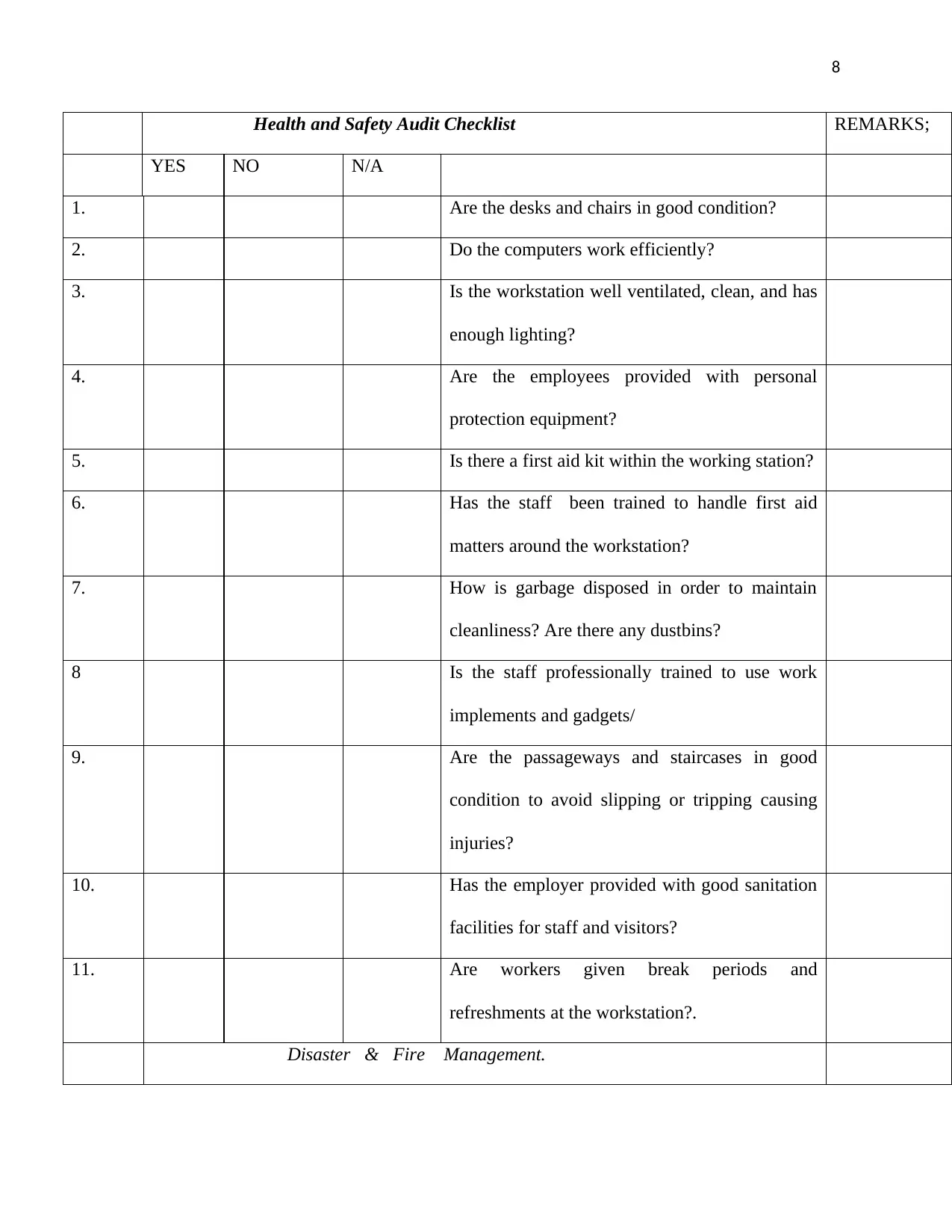
8
REMARKS;Health and Safety Audit Checklist
YES NO N/A
1. Are the desks and chairs in good condition?
2. Do the computers work efficiently?
3. Is the workstation well ventilated, clean, and has
enough lighting?
4. Are the employees provided with personal
protection equipment?
5. Is there a first aid kit within the working station?
6. Has the staff been trained to handle first aid
matters around the workstation?
7. How is garbage disposed in order to maintain
cleanliness? Are there any dustbins?
8 Is the staff professionally trained to use work
implements and gadgets/
9. Are the passageways and staircases in good
condition to avoid slipping or tripping causing
injuries?
10. Has the employer provided with good sanitation
facilities for staff and visitors?
11. Are workers given break periods and
refreshments at the workstation?.
Disaster & Fire Management.
REMARKS;Health and Safety Audit Checklist
YES NO N/A
1. Are the desks and chairs in good condition?
2. Do the computers work efficiently?
3. Is the workstation well ventilated, clean, and has
enough lighting?
4. Are the employees provided with personal
protection equipment?
5. Is there a first aid kit within the working station?
6. Has the staff been trained to handle first aid
matters around the workstation?
7. How is garbage disposed in order to maintain
cleanliness? Are there any dustbins?
8 Is the staff professionally trained to use work
implements and gadgets/
9. Are the passageways and staircases in good
condition to avoid slipping or tripping causing
injuries?
10. Has the employer provided with good sanitation
facilities for staff and visitors?
11. Are workers given break periods and
refreshments at the workstation?.
Disaster & Fire Management.
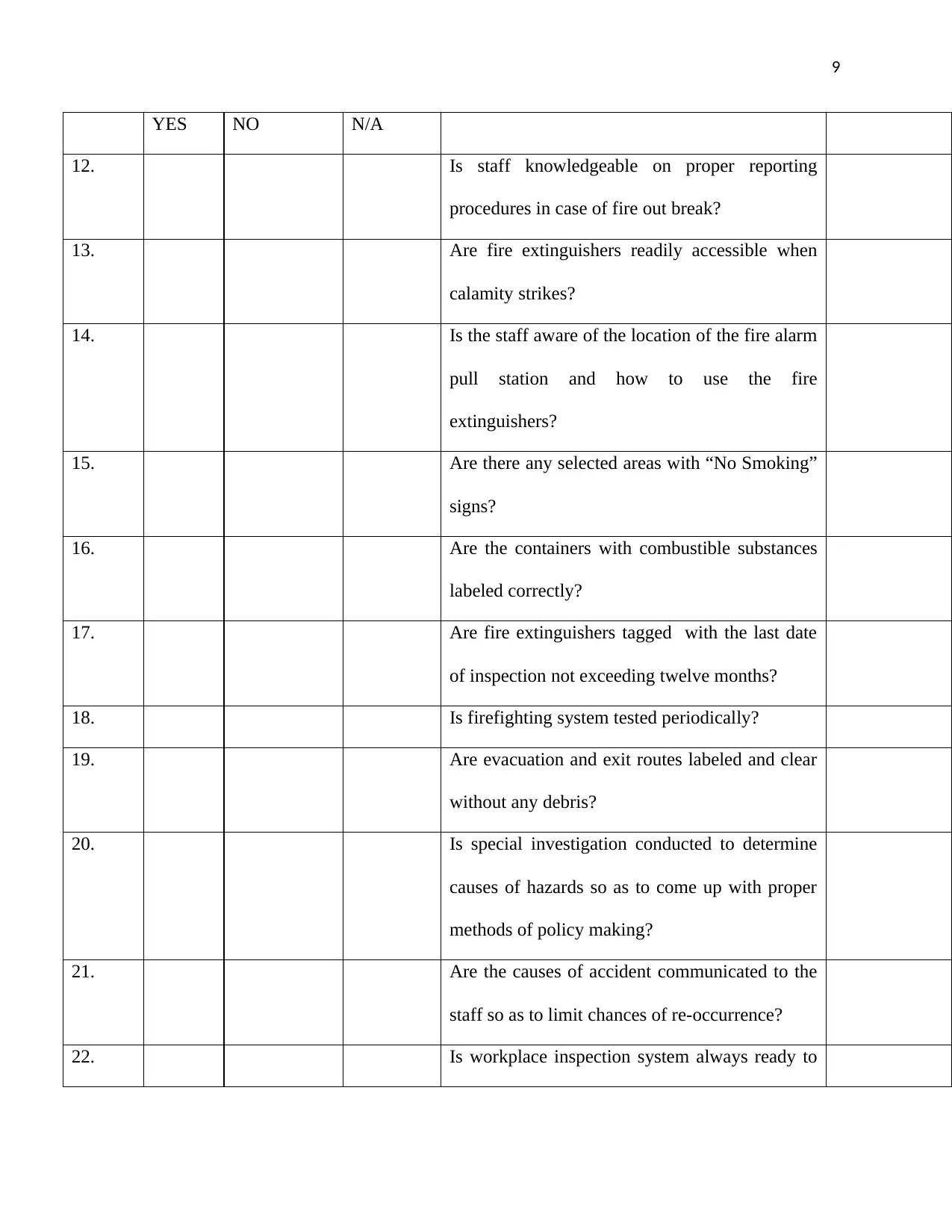
9
YES NO N/A
12. Is staff knowledgeable on proper reporting
procedures in case of fire out break?
13. Are fire extinguishers readily accessible when
calamity strikes?
14. Is the staff aware of the location of the fire alarm
pull station and how to use the fire
extinguishers?
15. Are there any selected areas with “No Smoking”
signs?
16. Are the containers with combustible substances
labeled correctly?
17. Are fire extinguishers tagged with the last date
of inspection not exceeding twelve months?
18. Is firefighting system tested periodically?
19. Are evacuation and exit routes labeled and clear
without any debris?
20. Is special investigation conducted to determine
causes of hazards so as to come up with proper
methods of policy making?
21. Are the causes of accident communicated to the
staff so as to limit chances of re-occurrence?
22. Is workplace inspection system always ready to
YES NO N/A
12. Is staff knowledgeable on proper reporting
procedures in case of fire out break?
13. Are fire extinguishers readily accessible when
calamity strikes?
14. Is the staff aware of the location of the fire alarm
pull station and how to use the fire
extinguishers?
15. Are there any selected areas with “No Smoking”
signs?
16. Are the containers with combustible substances
labeled correctly?
17. Are fire extinguishers tagged with the last date
of inspection not exceeding twelve months?
18. Is firefighting system tested periodically?
19. Are evacuation and exit routes labeled and clear
without any debris?
20. Is special investigation conducted to determine
causes of hazards so as to come up with proper
methods of policy making?
21. Are the causes of accident communicated to the
staff so as to limit chances of re-occurrence?
22. Is workplace inspection system always ready to
⊘ This is a preview!⊘
Do you want full access?
Subscribe today to unlock all pages.

Trusted by 1+ million students worldwide
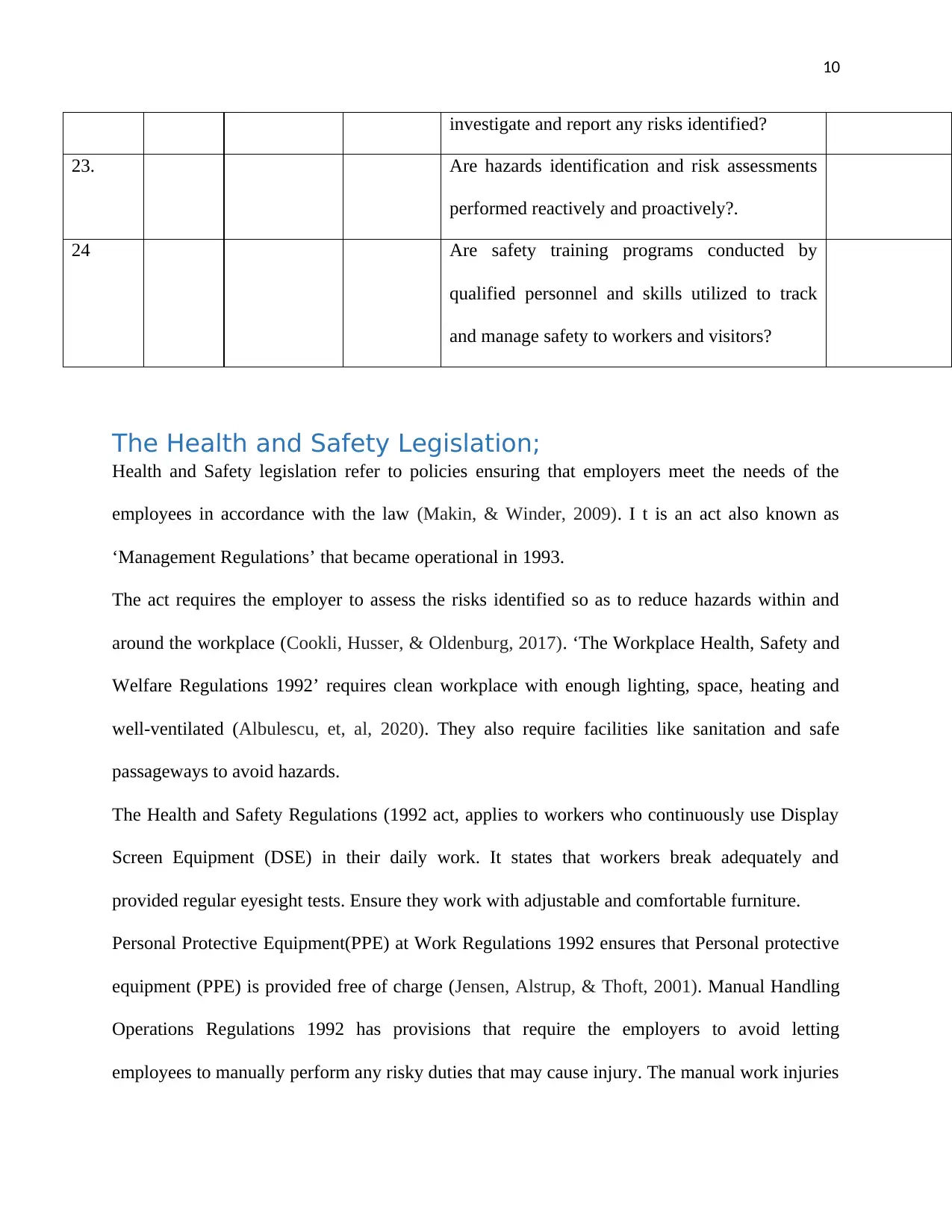
10
investigate and report any risks identified?
23. Are hazards identification and risk assessments
performed reactively and proactively?.
24 Are safety training programs conducted by
qualified personnel and skills utilized to track
and manage safety to workers and visitors?
The Health and Safety Legislation;
Health and Safety legislation refer to policies ensuring that employers meet the needs of the
employees in accordance with the law (Makin, & Winder, 2009). I t is an act also known as
‘Management Regulations’ that became operational in 1993.
The act requires the employer to assess the risks identified so as to reduce hazards within and
around the workplace (Cookli, Husser, & Oldenburg, 2017). ‘The Workplace Health, Safety and
Welfare Regulations 1992’ requires clean workplace with enough lighting, space, heating and
well-ventilated (Albulescu, et, al, 2020). They also require facilities like sanitation and safe
passageways to avoid hazards.
The Health and Safety Regulations (1992 act, applies to workers who continuously use Display
Screen Equipment (DSE) in their daily work. It states that workers break adequately and
provided regular eyesight tests. Ensure they work with adjustable and comfortable furniture.
Personal Protective Equipment(PPE) at Work Regulations 1992 ensures that Personal protective
equipment (PPE) is provided free of charge (Jensen, Alstrup, & Thoft, 2001). Manual Handling
Operations Regulations 1992 has provisions that require the employers to avoid letting
employees to manually perform any risky duties that may cause injury. The manual work injuries
investigate and report any risks identified?
23. Are hazards identification and risk assessments
performed reactively and proactively?.
24 Are safety training programs conducted by
qualified personnel and skills utilized to track
and manage safety to workers and visitors?
The Health and Safety Legislation;
Health and Safety legislation refer to policies ensuring that employers meet the needs of the
employees in accordance with the law (Makin, & Winder, 2009). I t is an act also known as
‘Management Regulations’ that became operational in 1993.
The act requires the employer to assess the risks identified so as to reduce hazards within and
around the workplace (Cookli, Husser, & Oldenburg, 2017). ‘The Workplace Health, Safety and
Welfare Regulations 1992’ requires clean workplace with enough lighting, space, heating and
well-ventilated (Albulescu, et, al, 2020). They also require facilities like sanitation and safe
passageways to avoid hazards.
The Health and Safety Regulations (1992 act, applies to workers who continuously use Display
Screen Equipment (DSE) in their daily work. It states that workers break adequately and
provided regular eyesight tests. Ensure they work with adjustable and comfortable furniture.
Personal Protective Equipment(PPE) at Work Regulations 1992 ensures that Personal protective
equipment (PPE) is provided free of charge (Jensen, Alstrup, & Thoft, 2001). Manual Handling
Operations Regulations 1992 has provisions that require the employers to avoid letting
employees to manually perform any risky duties that may cause injury. The manual work injuries
Paraphrase This Document
Need a fresh take? Get an instant paraphrase of this document with our AI Paraphraser
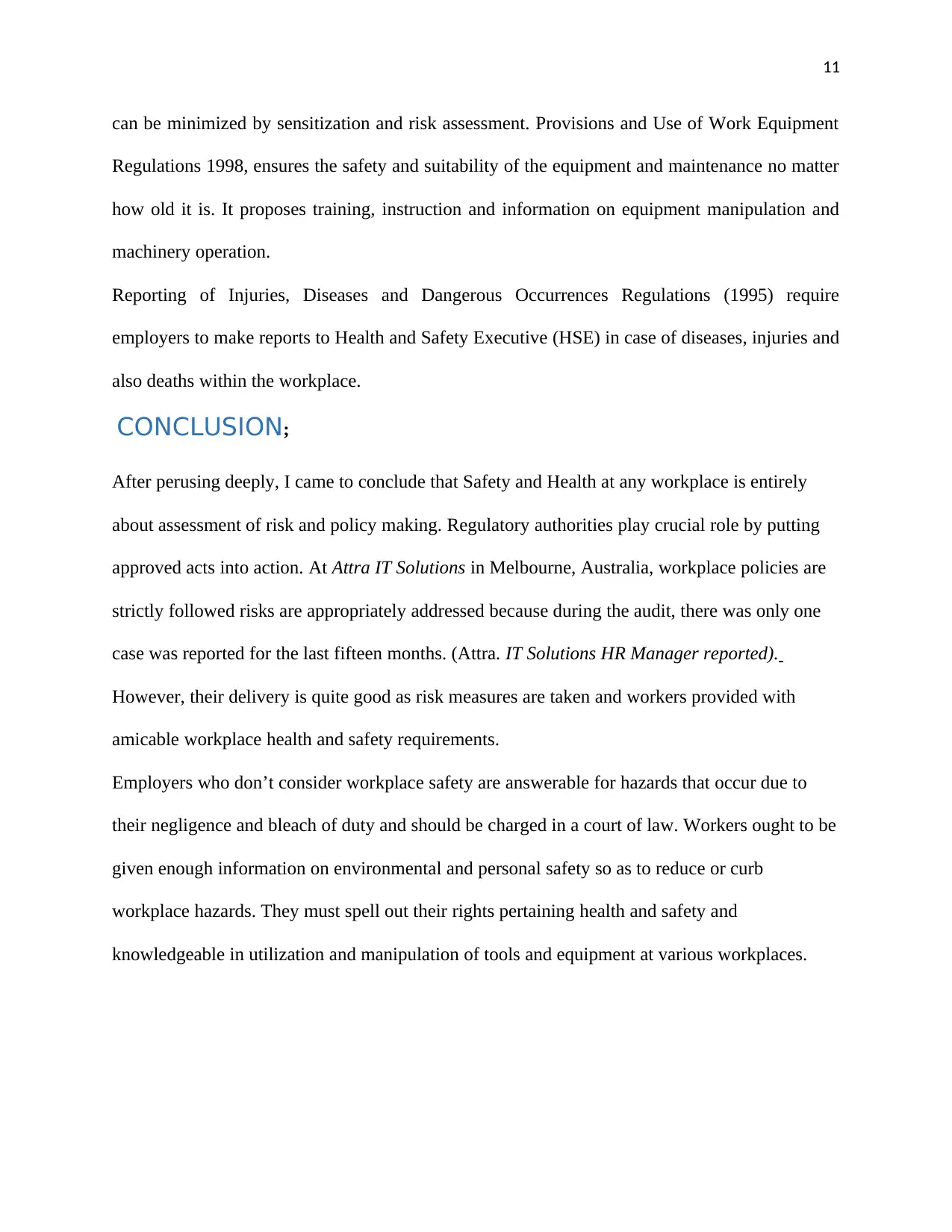
11
can be minimized by sensitization and risk assessment. Provisions and Use of Work Equipment
Regulations 1998, ensures the safety and suitability of the equipment and maintenance no matter
how old it is. It proposes training, instruction and information on equipment manipulation and
machinery operation.
Reporting of Injuries, Diseases and Dangerous Occurrences Regulations (1995) require
employers to make reports to Health and Safety Executive (HSE) in case of diseases, injuries and
also deaths within the workplace.
CONCLUSION;
After perusing deeply, I came to conclude that Safety and Health at any workplace is entirely
about assessment of risk and policy making. Regulatory authorities play crucial role by putting
approved acts into action. At Attra IT Solutions in Melbourne, Australia, workplace policies are
strictly followed risks are appropriately addressed because during the audit, there was only one
case was reported for the last fifteen months. (Attra. IT Solutions HR Manager reported).
However, their delivery is quite good as risk measures are taken and workers provided with
amicable workplace health and safety requirements.
Employers who don’t consider workplace safety are answerable for hazards that occur due to
their negligence and bleach of duty and should be charged in a court of law. Workers ought to be
given enough information on environmental and personal safety so as to reduce or curb
workplace hazards. They must spell out their rights pertaining health and safety and
knowledgeable in utilization and manipulation of tools and equipment at various workplaces.
can be minimized by sensitization and risk assessment. Provisions and Use of Work Equipment
Regulations 1998, ensures the safety and suitability of the equipment and maintenance no matter
how old it is. It proposes training, instruction and information on equipment manipulation and
machinery operation.
Reporting of Injuries, Diseases and Dangerous Occurrences Regulations (1995) require
employers to make reports to Health and Safety Executive (HSE) in case of diseases, injuries and
also deaths within the workplace.
CONCLUSION;
After perusing deeply, I came to conclude that Safety and Health at any workplace is entirely
about assessment of risk and policy making. Regulatory authorities play crucial role by putting
approved acts into action. At Attra IT Solutions in Melbourne, Australia, workplace policies are
strictly followed risks are appropriately addressed because during the audit, there was only one
case was reported for the last fifteen months. (Attra. IT Solutions HR Manager reported).
However, their delivery is quite good as risk measures are taken and workers provided with
amicable workplace health and safety requirements.
Employers who don’t consider workplace safety are answerable for hazards that occur due to
their negligence and bleach of duty and should be charged in a court of law. Workers ought to be
given enough information on environmental and personal safety so as to reduce or curb
workplace hazards. They must spell out their rights pertaining health and safety and
knowledgeable in utilization and manipulation of tools and equipment at various workplaces.
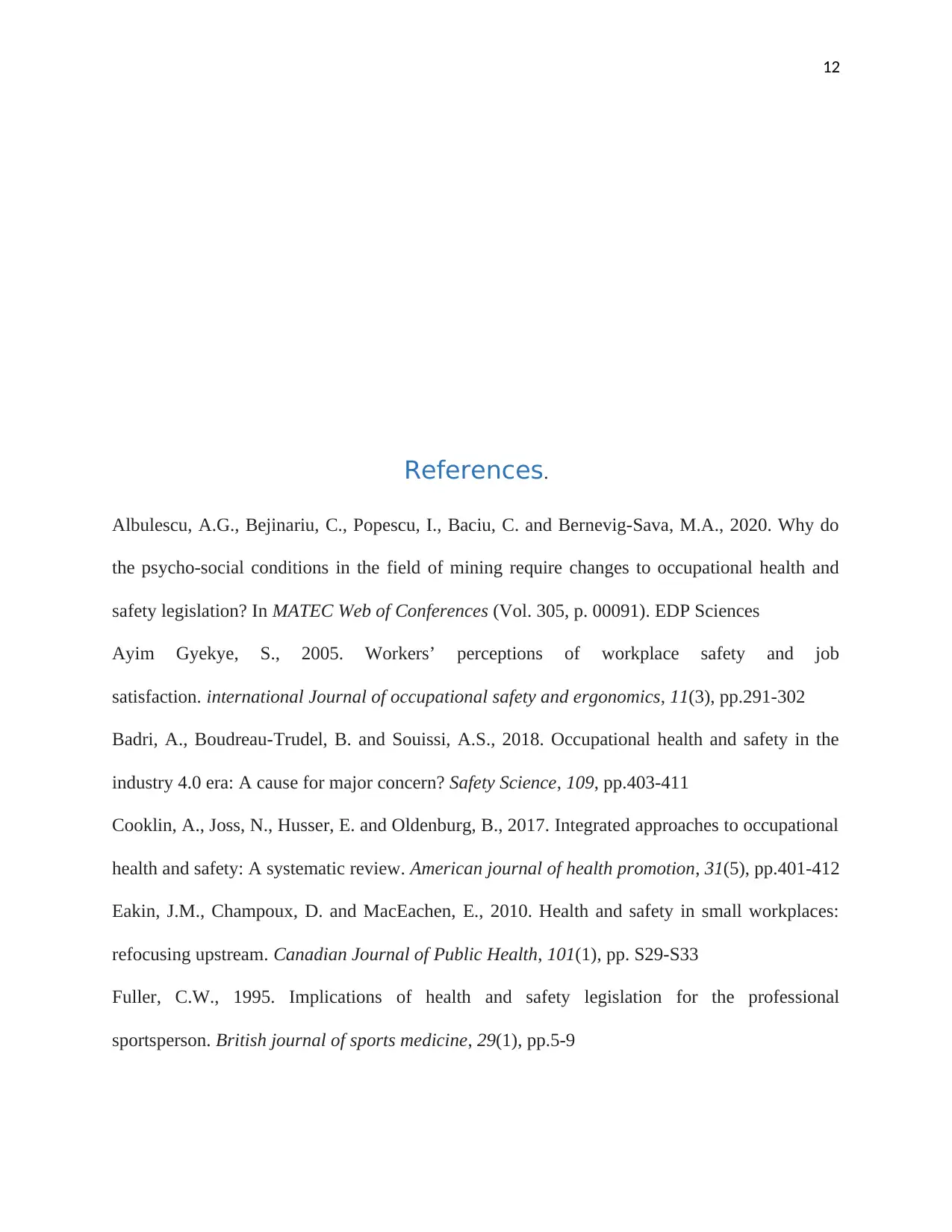
12
References.
Albulescu, A.G., Bejinariu, C., Popescu, I., Baciu, C. and Bernevig-Sava, M.A., 2020. Why do
the psycho-social conditions in the field of mining require changes to occupational health and
safety legislation? In MATEC Web of Conferences (Vol. 305, p. 00091). EDP Sciences
Ayim Gyekye, S., 2005. Workers’ perceptions of workplace safety and job
satisfaction. international Journal of occupational safety and ergonomics, 11(3), pp.291-302
Badri, A., Boudreau-Trudel, B. and Souissi, A.S., 2018. Occupational health and safety in the
industry 4.0 era: A cause for major concern? Safety Science, 109, pp.403-411
Cooklin, A., Joss, N., Husser, E. and Oldenburg, B., 2017. Integrated approaches to occupational
health and safety: A systematic review. American journal of health promotion, 31(5), pp.401-412
Eakin, J.M., Champoux, D. and MacEachen, E., 2010. Health and safety in small workplaces:
refocusing upstream. Canadian Journal of Public Health, 101(1), pp. S29-S33
Fuller, C.W., 1995. Implications of health and safety legislation for the professional
sportsperson. British journal of sports medicine, 29(1), pp.5-9
References.
Albulescu, A.G., Bejinariu, C., Popescu, I., Baciu, C. and Bernevig-Sava, M.A., 2020. Why do
the psycho-social conditions in the field of mining require changes to occupational health and
safety legislation? In MATEC Web of Conferences (Vol. 305, p. 00091). EDP Sciences
Ayim Gyekye, S., 2005. Workers’ perceptions of workplace safety and job
satisfaction. international Journal of occupational safety and ergonomics, 11(3), pp.291-302
Badri, A., Boudreau-Trudel, B. and Souissi, A.S., 2018. Occupational health and safety in the
industry 4.0 era: A cause for major concern? Safety Science, 109, pp.403-411
Cooklin, A., Joss, N., Husser, E. and Oldenburg, B., 2017. Integrated approaches to occupational
health and safety: A systematic review. American journal of health promotion, 31(5), pp.401-412
Eakin, J.M., Champoux, D. and MacEachen, E., 2010. Health and safety in small workplaces:
refocusing upstream. Canadian Journal of Public Health, 101(1), pp. S29-S33
Fuller, C.W., 1995. Implications of health and safety legislation for the professional
sportsperson. British journal of sports medicine, 29(1), pp.5-9
⊘ This is a preview!⊘
Do you want full access?
Subscribe today to unlock all pages.

Trusted by 1+ million students worldwide
1 out of 14
Related Documents
Your All-in-One AI-Powered Toolkit for Academic Success.
+13062052269
info@desklib.com
Available 24*7 on WhatsApp / Email
![[object Object]](/_next/static/media/star-bottom.7253800d.svg)
Unlock your academic potential
Copyright © 2020–2025 A2Z Services. All Rights Reserved. Developed and managed by ZUCOL.





